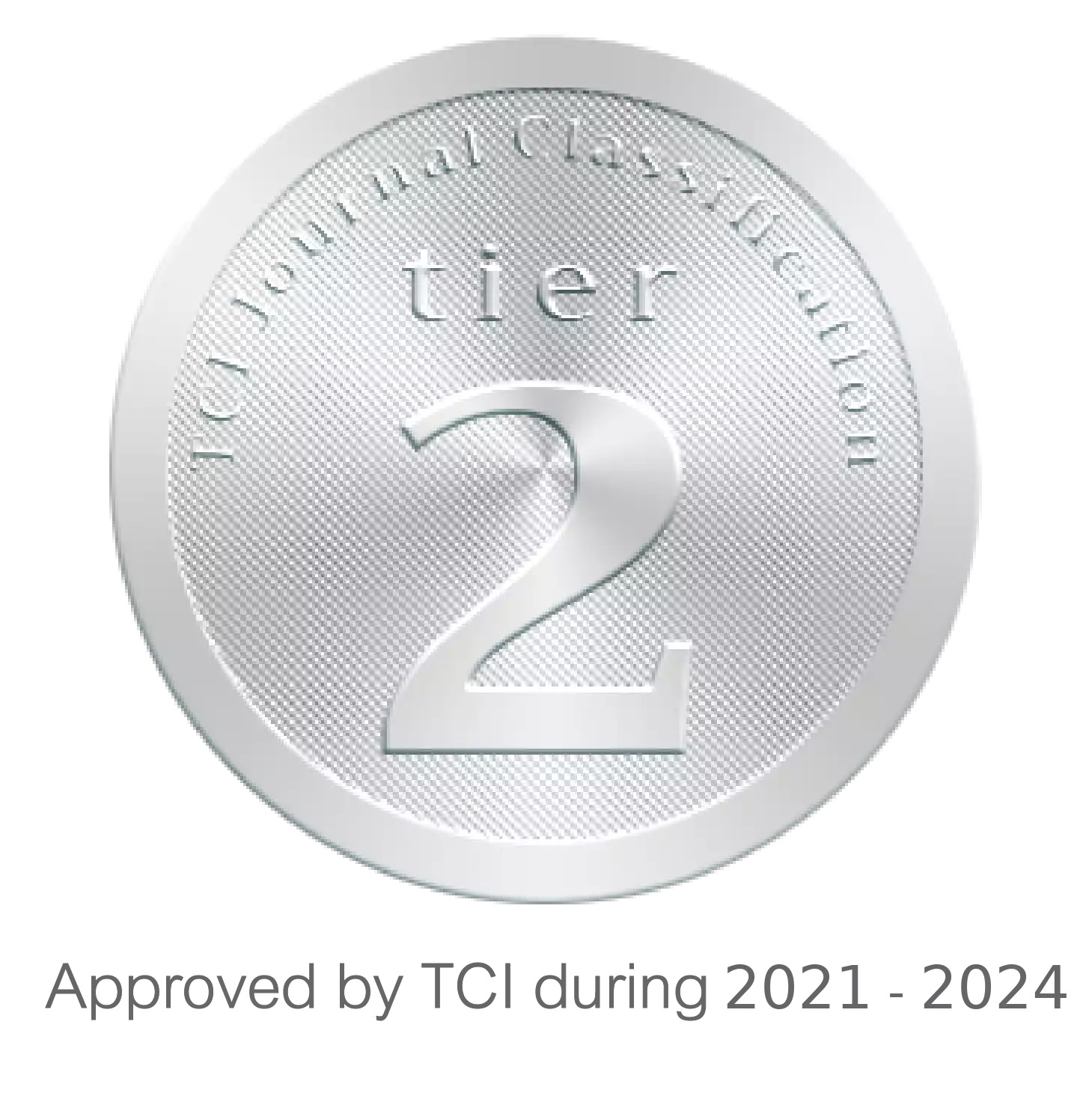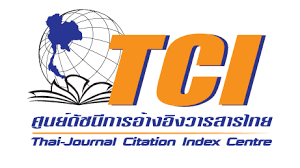THE INFLUENCES OF CORPORATE BRAND IMAGE TOWARDS CUSTOMERS’ INTENTION TO USE AND LOYALTY AT UPPER-NORTHEASTERN AIRPORTS
Keywords:
corporate brand image, intention to use, customer loyalty, airport, low-cost airline, structural equation modelAbstract
การวิจัยครั้งนี้มีวัตถุประสงค์ เพื่อ 1) ศึกษาระดับการรับรู้ของภาพลักษณ์องค์กร ความตั้งใจใช้บริการ และความจงรักภักดี ของสายการบินต้นทุนต่ำ 2) ศึกษาอิทธิพลของภาพลักษณ์องค์กรที่มีต่อความตั้งใจใช้บริการ และความจงรักภักดี ของสายการบินต้นทุนต่ำ 3) ศึกษาบทบาทความเป็นตัวแปรแทรกของความตั้งใจใช้บริการที่มีต่อภาพลักษณ์องค์กรและความจงรักภักดี โดยใช้แบบสอบถามเป็นเครื่องมือในการเก็บข้อมูลผู้ใช้บริการ ณ ท่าอากาศยานเขตภาคตะวันออกเฉียงเหนือตอนบนทั้งหมด 4 ท่าอากาศยาน จำนวน 399 คน หลังจากนั้นนำไปหาค่าความเชื่อมั่นโดยใช้วิธีหาค่าสัมประสิทธิ์แอลฟาของครอนบาค สถิติที่ใช้ในการวิเคราะห์ข้อมูล ได้แก่ ความถี่ ร้อยละ และการวิเคราะห์โมเดลสมการโครงสร้าง ผลการศึกษาพบว่า ผู้ตอบแบบสอบถามส่วนมากเป็นเพศหญิง 291 ราย (ร้อยละ 72.90) มีอายุระหว่าง 31-40 ปี 177 ราย (ร้อยละ 44.40) ระดับการศึกษาปริญญาตรี 271 ราย (ร้อยละ 67.90) ประกอบอาชีพข้าราชการ/พนักงานของรัฐ 191 ราย (ร้อยละ 47.90) รายได้เฉลี่ยต่อเดือน 15,001-25,00 บาท 189 ราย (ร้อยละ 47.40) และสายการบินที่ใช้บ่อยที่สุดภายใน 6 เดือน คือ นกแอร์ 276 ราย (ร้อยละ 64.50) ผลการทดสอบสมมติฐานพบว่า ภาพลักษณ์องค์กรของสายการบินมีอิทธิพลทางตรงเชิงบวกต่อความตั้งใจใช้บริการและความจงรักภักดีอย่างมีนัยสำคัญ และความตั้งใจใช้บริการมีอิทธิพลทางตรงเชิงบวกต่อความจงรักภักดีอย่างมีนัยสำคัญ สำหรับการทดสอบอิทธิพลของตัวแปรแทรกกลาง พบว่า ความตั้งใจใช้บริการเป็นตัวแปรแทรกกลางแบบบางส่วน
Downloads
References
ปิยะนุช สถาพงศ์ภักดี. (2564). แนวโน้มธุรกิจ/อุตสาหกรรม ปี 2564-66 ธุรกิจบริการขนส่งทางอากาศ. วิจัยกรุงศรี. สืบค้นเมื่อ 29 เมษายน 2566, จาก https://www.krungsri.com/getmedia/c8ca3a9b-43ee-4d82-872d-712ba3ba57cf/IO_Air_Transport_210303_TH_EX.pdf.aspx.
เปรมฤดี จิตรเกื้อกูล. (2560). บทบาทของความน่าเชื่อถือของตราสินค้าในการเป็นตัวแปรแทรกระหว่างความคุ้นเคยต่อตราสินค้าและทัศนคติที่มีต่อตราสินค้าเพื่อสิ่งแวดล้อม. ศรีปทุมปริทัศน์ฉบับมนุษยศาสตร์และสังคมศาสตร์.
นิรััชยา เลิศเรืองฤทธิ์. (2559). การรับรู้คุณค่าตราสินค้าและพฤติกรรมที่มีต่อสายการบินต้นทุนตํ่า ของผู้โดยสารชาวไทย: กรณีศึกษาสายการบินไทยแอร์เอเชีย (ปริญญานิพนธ์ปริญญามหาบัณฑิต). มหาวิทยาลัยธรรมศาสตร์. กรุงเทพฯ.
สำนักงานเลขาธิการวุฒิสภา. (2565). รายงานการพิจารณาศึกษาเรื่องมาตรการสนับสนุนสายการบินของไทยภายใต้นโยบายการเปิดน่านฟ้าเสรี. สืบค้นเมื่อ 20 เมษายน 2566, จาก https://www.senate.go.th/document/ Ext27141/27141728_0002.PDF
Agmeka, F., Wathoni, R.N., & Santoso, A.S. (2019). The influence of discount framing towards brandreputation and brand image on purchase intention and actual behaviour in e-commerce. Procedia Computer Science, 161, 851-858.
Alam, M., & Noor, N. (2020). The relationship between service quality. corporate image, and customer loyalty of generation Y: an application of S-O-R paradigm in the context of superstores in Bangladesh. Sage Open, 10(2).
Baker, D. Mc. A., (2013). Service quality and customer satisfaction in the airline industry: A comparison between legacy airlines and low-cost airlines. American Journal of Tourism Research, 2(1), 67-77.
Balmer, J. M., Lin, Z., Chen, W., & He, X. (2020). The role of corporate brand image for B2B relationships of logistics service providers in China. Journal of Business Research, 117, 850-861.
Bentler, P. M. (1992). On the fit of models to covariances and methodology to the Bulletin. Psychological bulletin, 112(3), 400.
Bergkvist, L., & Rossiter, J. R. (2007). The predictive validity of multiple-item versus single-item measures of the same constructs. Journal of marketing research, 44(2), 175-184.
Bowen, J. T., & Shoemaker, S. (2003). Loyalty: A strategic commitment. The Cornell Hotel and Restaurant Administration Quarterly, 44(5-6), 31-46.
Byrne, B. M. (2013). Structural equation modeling with AMOS: Basic concepts, applications, and programming. Routledge.
Callarisa, L., Garcı´a, J.S., Cardiff, J., & Roshchina, A. (2012). Harnessing social media platforms to measure customer-based hotel brand equity. Tourism Management Perspectives, 4, 73-79.
Chan, V., Chiu, D., & Ho, K. (2022). Mediating effects on the relationship between perceived service quality and public library app loyalty during the COVID-19 era. Journal of Retailing and Consumer Services, 67, 102960.
Chin, W. W. (1998). The partial least squares approach to structural equation modeling. Modern methods for business research, 295(2), 295-336.
Cronbach, L. J. (1974). Consistency and Stability of Interaction Effects from Classroom to Classroom. Pilot Studies.
Eun-Ju S., & P. Jin-Woo. (2017). A Study on the Impact of Airline Corporate Reputation on Customer loyalty. International Business Research, 10(1), 59-67.
Fornell, C., & Larcker, D. F. (1981). Evaluating structural equation models with unobservable variables and measurement error. Journal of marketing research, 18(1), 39-50.
Fu, Y. K. (2023). Airline brand image, passenger perceived value and loyalty towards full-service and low-cost carriers. Tourism Review, (ahead-of-print).
Gronholdt, L., Martensen, A., & Kristensen, K. (2000). The relationship between customer satisfaction and loyalty: cross-industry differences. Total quality management, 11(4-6), 509-514.
Hair, J. F., Black, W. C., Babin, B. J., & Anderson, R. E. (2010). Multivariate data analysis. Prentice Hall.
Hair, J. F., Hult, G. T. M., Ringle, C. M., & Sarstedt, M. (2014). A Primer on Partial Least Squares Structural Equation Modeling. Thousand Oaks: Sage.
Han, H., Lee, K. S., Chua, B. L., Lee, S., & Kim, W. (2019). Role of airline food quality, price reasonableness, image, satisfaction, and attachment in building re-flying intention. International Journal of Hospitality Management, 80, 91-100.
Han, H., Yu, J., Chua, B.L., Lee, S., & Kim, W. (2019). Impact of core-product and service-encounter quality, attitude, image, trust and love on repurchase: full-service vs low-cost carriers in South Korea. International Journal of Contemporary Hospitality Management, 33(4), 1588-1608.
Hirschman, A.O. (1970). Exit, Voice, and Loyalty: Responses to Decline in Firms, Organizations, and States. Harvard University Press: Cambridge, MA, USA.
Hu, L. T., & Bentler, P. M. (1999). Cutoff criteria for fit indexes in covariance structure analysis: Conventional criteria versus new alternatives. Structural equation modeling: a multidisciplinary journal, 6(1), 1-55.
Keller, T. (2003). Parental images as a guide to leadership sensemaking: An attachment perspective on implicit leadership theories. The Leadership Quarterly, 14(2), 141-160.
Lardinoit, T., & Derbaix, C. (2001). Sponsorship and recall of sponsors. Psychology & Marketing, 18(2), 167-190.
Liang, J. K., Eccarius, T., & Lu, C. C. (2022). Investigating re-use intentions for shared bicycles: A loyalty phase perspective. Research in Transportation Business & Management, 43, 100696.
Likert, R. (1932). A technique for the measurement of attitudes. Archives of psychology.
Oliver, R. L. (1999). Whence consumer loyalty?. Journal of marketing, 63(4_suppl1), 33-44.
Raza, M., Salleh, S., Tariq, B., Altayyar, R., & Shaari, H. (2020). Investigating the effects of customer-based brand equity on turnover intentions with mediating effect of customer citizenship behavior. Management Science Letters, 10(2), 279-286.
Schreiber, J. B., Nora, A., Stage, F. K., Barlow, E. A., & King, J. (2006). Reporting structural equation modeling and confirmatory factor analysis results: A review. The Journal of educational research, 99(6), 323-338.
Singh, G., Slack, N., Sharma, S., Mudaliar, K., Narayan, S., Kaur, R., & Sharma, K.U. (2021). Antecedents involved in developing fast-food restaurant customer loyalty. The TQM Journal, 33(8), 1753-1769.
Tabachnick, B. G., Fidell, L. S., & Ullman, J. B. (2013). Using multivariate statistics (Vol. 6, pp. 497-516). Boston, MA: pearson.
Wang, Y. H., & Tsai, C. F. (2014). The relationship between brand image and purchase intention from award winning mutual funds. The International Journal of Business and Finance Research, 8(2), 27-40.
White, K. J. (1992). The Durbin-Watson test for autocorrelation in nonlinear models. The Review of Economics and Statistics, 370-373.
Wu, L. (2011). Satisfaction, inertia, and customer loyalty in the varying levels of the zone of tolerance and alternative attractiveness. Journal of Services Marketing, 25(5). 310-322.
Yang, K. C., Hsieh, T. C., Li, H., & Yang, C. (2012). Assessing how service quality, airline image and customer value affect the intentions of passengers regarding low-cost carriers. Journal of Air Transport Management, 20, 52-53.









